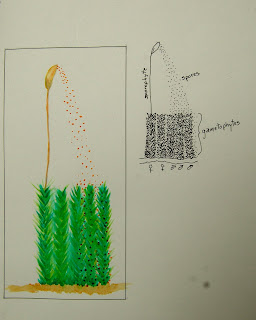I almost titled this one "Mosses and the Invention of Sex," but thought better of it. Last week near Bear Creek Falls, we saw lots of mosses up close, after having seen many at 55 mph on our way to the rest stop where our hike began. The way mosses reproduce is quite interesting as is their ability to survive extremes of weather and climate.
The page from my journal displayed above is a work in progress. I'll add more detail to the painting and print a descriptive paragraph by hand in the lower right quadrant. Here's a preview of the text:
If we start with the spores, the little burnt sienna dots dropping from the yellowish capsule, we are looking at particles that behave more or less like seeds in more advanced plants. When they hit the ground, under suitable conditions they will grow into male or female green plants. These are called gametophytes (see inked diagram, upper right), as they produce gametes. You usually can't tell the male and female gametophytes apart without aid of a hand lens. Gamete is a collective term for male and female sex cells, called sperm and eggs in animals. When it rains, or when there is sufficient accumulation of dew, the male sex organs (antheridia) on the tops of the male gametophytes, release sperm cells which swim until they meet up with the female sex organs (archegonia) on the tops of the female gametophytes. The female sex organs contain eggs. When an egg is fertilized, it grows a new kind of plant right on top of the female gametophyte. This tall, brownish plant is called a sporophyte since it will since it will produce spores in the capsule known as a sporangium. As you can imagine, in a dense mat of moss, sperm from one plant may fertilize eggs from another. This mixing of genes from different sources is one of the advantages of sexual reproduction. It creates diversity which means an increased chance that the species will have at least some of its members able to adapt to changing conditions. With asexual reproduction, all members of a species may be nearly identical, and an environmental change that eliminates one could eliminate them all. The phrase "strength in diversity" has layers of meaning. This pattern called "alternation of generations" occurs in other groups of plants and animals such as ferns and jellyfish.
THe next time you see a dense patch of moss, look closely and see if you can see the little brownish-yellow sporophytes. They only appear seasonally, but tend to persist long after they have dropped their spores. I posted a photo of moss a couple of days ago, and although it's not a great photo, you can see the sporophytes. When evolution produces such wondrous processes to admire, it's hard to bring myself to scrape the moss off my shingles or fence posts which is advisable if I want to avoid later maintenance costs.
Tuesday, February 21, 2012
Subscribe to:
Post Comments (Atom)


No comments:
Post a Comment